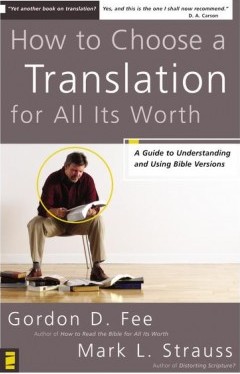Gordon Fee and Mark Strauss: How To Choose a Translation for All Its Worth
 Gordon D. Fee and Mark L. Strauss, How To Choose a Translation for All Its Worth: A Guide to Understanding and Using Bible Versions (Grand Rapids: Zondervan, 2007), 170 pages, ISBN 0310278767.
Gordon D. Fee and Mark L. Strauss, How To Choose a Translation for All Its Worth: A Guide to Understanding and Using Bible Versions (Grand Rapids: Zondervan, 2007), 170 pages, ISBN 0310278767.
This is the third “how to” book that Gordon Fee has written. The first two books were How To Read the Bible for All Its Worth and How To Read the Bible Book By Book, both of which were coauthored with Douglas Stuart, Fee’s former colleague at Gordon-Conwell Theological Seminary. For this third book Fee has teamed up with Mark Strauss. Fee and Strauss are both New Testament scholars and both have been involved in the work of bible translation.
In some places in the world a book like How To Choose a Translation for All Its Worth would not be needed. There are places where a variety of bible translations are not available; in fact some people groups only have one translation of the bible (or select Scripture portions). In the United States, and other English speaking countries, this is not the case; there are a lot of different English bible translations from which one can choose. The wealth of translations that are available is a blessing, but it can also be a problematic, it causes many believers to ask the question “which one is the best?” The problem is compounded by the fact that not everyone agrees on which translation is best or the most faithful to the biblical text. One of the more obvious indications of this is the “King James Only Debate.”
In this book Fee and Strauss explain some of the challenges faced by bible translators as well as the different philosophies that guide translators in the making a translation. The book is divided into four parts. Part one is “The Task of Translation.” Under this section the authors address the need for translation and the meaning and task of translation. Part two is titled “Making Words Work.” In this section they address the subject of translating words, giving special attention to figurative language-such as idioms, metaphors and poetry; they also address the problem of translating the Greek genitive. Part three is “Translation and Culture.” In this section they deal with cultural issues related to translation and the issue of using gender inclusive language in bible translation. Part four is titled “The Bible in English” which gives a short history of English translations of the bible. In this section the authors also set forth the strengths and weakness of some of the more well-known English translations and give their recommendations for the best translations.
This book contains some very helpful information. One thing that the authors make clear is that no one translation has it all, that is; there is no perfect bible translation. Every translation is by its very nature already an interpretation. Translators read the biblical text, either in Hebrew or in Greek, and then seek to find appropriate words in English to convey the meaning of the text. This is not always easy because sometimes there are not words that are exact equivalents. In cases where there are exact equivalents translators, at times, do not use the exact equivalent because doing so would make the translation difficult, if not unintelligible in English. Bible translations typically fall into one of two categories. Form equivalents seek to be very literal while functional equivalents are more concerned with trying to convey the sense of the text rather than a word-for-word translation. Bible readers are divided over which is the better translation to use. The authors demonstrate that even the literal translations are not always really literal. Fee and Strauss think that the best translations are those that convey the meaning of the text they say: “Accuracy in translation relates to equivalent meaning, not equivalent form” (page 27). In their view, this is what being faithful to the biblical text is.
Category: Biblical Studies, Summer 2008


